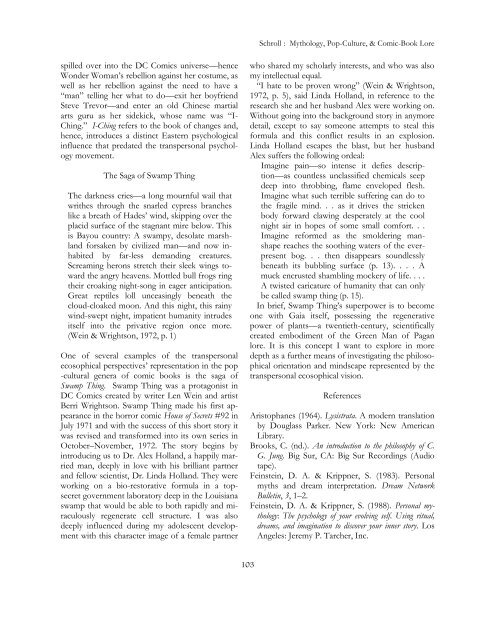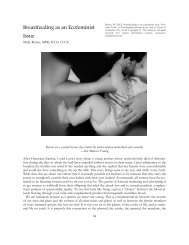RE:IJSNC, Issue 1, Volume 2, May 2012 - Ocean Seminary College
RE:IJSNC, Issue 1, Volume 2, May 2012 - Ocean Seminary College
RE:IJSNC, Issue 1, Volume 2, May 2012 - Ocean Seminary College
Create successful ePaper yourself
Turn your PDF publications into a flip-book with our unique Google optimized e-Paper software.
spilled over into the DC Comics universe—hence<br />
Wonder Woman’s rebellion against her costume, as<br />
well as her rebellion against the need to have a<br />
“man” telling her what to do—exit her boyfriend<br />
Steve Trevor—and enter an old Chinese martial<br />
arts guru as her sidekick, whose name was “I-<br />
Ching.” I-Ching refers to the book of changes and,<br />
hence, introduces a distinct Eastern psychological<br />
influence that predated the transpersonal psychology<br />
movement.<br />
The Saga of Swamp Thing<br />
The darkness cries—a long mournful wail that<br />
writhes through the snarled cypress branches<br />
like a breath of Hades’ wind, skipping over the<br />
placid surface of the stagnant mire below. This<br />
is Bayou country: A swampy, desolate marshland<br />
forsaken by civilized man—and now inhabited<br />
by far-less demanding creatures.<br />
Screaming herons stretch their sleek wings toward<br />
the angry heavens. Mottled bull frogs ring<br />
their croaking night-song in eager anticipation.<br />
Great reptiles loll unceasingly beneath the<br />
cloud-cloaked moon. And this night, this rainy<br />
wind-swept night, impatient humanity intrudes<br />
itself into the privative region once more.<br />
(Wein & Wrightson, 1972, p. 1)<br />
One of several examples of the transpersonal<br />
ecosophical perspectives’ representation in the pop<br />
-cultural genera of comic books is the saga of<br />
Swamp Thing. Swamp Thing was a protagonist in<br />
DC Comics created by writer Len Wein and artist<br />
Berri Wrightson. Swamp Thing made his first appearance<br />
in the horror comic House of Secrets #92 in<br />
July 1971 and with the success of this short story it<br />
was revised and transformed into its own series in<br />
October–November, 1972. The story begins by<br />
introducing us to Dr. Alex Holland, a happily married<br />
man, deeply in love with his brilliant partner<br />
and fellow scientist, Dr. Linda Holland. They were<br />
working on a bio-restorative formula in a topsecret<br />
government laboratory deep in the Louisiana<br />
swamp that would be able to both rapidly and miraculously<br />
regenerate cell structure. I was also<br />
deeply influenced during my adolescent development<br />
with this character image of a female partner<br />
103<br />
Schroll : Mythology, Pop-Culture, & Comic-Book Lore<br />
who shared my scholarly interests, and who was also<br />
my intellectual equal.<br />
“I hate to be proven wrong” (Wein & Wrightson,<br />
1972, p. 5), said Linda Holland, in reference to the<br />
research she and her husband Alex were working on.<br />
Without going into the background story in anymore<br />
detail, except to say someone attempts to steal this<br />
formula and this conflict results in an explosion.<br />
Linda Holland escapes the blast, but her husband<br />
Alex suffers the following ordeal:<br />
Imagine pain—so intense it defies description—as<br />
countless unclassified chemicals seep<br />
deep into throbbing, flame enveloped flesh.<br />
Imagine what such terrible suffering can do to<br />
the fragile mind. . . as it drives the stricken<br />
body forward clawing desperately at the cool<br />
night air in hopes of some small comfort. . .<br />
Imagine reformed as the smoldering manshape<br />
reaches the soothing waters of the everpresent<br />
bog. . . then disappears soundlessly<br />
beneath its bubbling surface (p. 13). . . . A<br />
muck encrusted shambling mockery of life. . . .<br />
A twisted caricature of humanity that can only<br />
be called swamp thing (p. 15).<br />
In brief, Swamp Thing’s superpower is to become<br />
one with Gaia itself, possessing the regenerative<br />
power of plants—a twentieth-century, scientifically<br />
created embodiment of the Green Man of Pagan<br />
lore. It is this concept I want to explore in more<br />
depth as a further means of investigating the philosophical<br />
orientation and mindscape represented by the<br />
transpersonal ecosophical vision.<br />
References<br />
Aristophanes (1964). Lysistrata. A modern translation<br />
by Douglass Parker. New York: New American<br />
Library.<br />
Brooks, C. (nd.). An introduction to the philosophy of C.<br />
G. Jung. Big Sur, CA: Big Sur Recordings (Audio<br />
tape).<br />
Feinstein, D. A. & Krippner, S. (1983). Personal<br />
myths and dream interpretation. Dream Network<br />
Bulletin, 3, 1–2.<br />
Feinstein, D. A. & Krippner, S. (1988). Personal mythology:<br />
The psychology of your evolving self. Using ritual,<br />
dreams, and imagination to discover your inner story. Los<br />
Angeles: Jeremy P. Tarcher, Inc.



